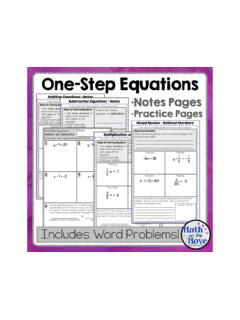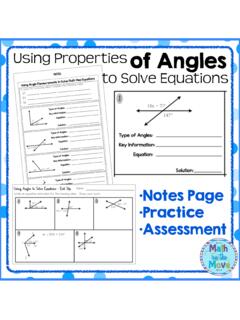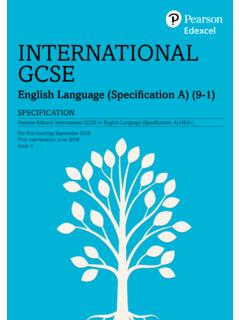Transcription of Find the unit rate - MATH 2017-2018
1 56 action-packed pages filled with guided notes, worksheets, math poetry , activities, and assessments! A complete unit for mastering ratios, rates , and proportions in two weeks or less! Barry Schneiderman, 2013 Great gas mileage! 115 miles 5 gallons Find the unit rate: Instructions for the teacher Here it is at last the real deal! Everything you need to introduce students to ratio, rate, unit rate, and proportion concepts and ensure they understand and retain them! This product addresses sixth, seventh, and eighth grade common core standards, but can also be used for advanced fifth grade students. Follow these instructions and use the various materials step-by-step, and your students will not only learn how to solve ratio, rate, and proportion problems, but also discover why we use them and their incredible value and versatility in solving day-to-day real-world problems. This product is broken up into six different sections: Includes a warm-up activity, note-taking page, illustrated poetry , and worksheet.
2 Includes a warm-up activity, note-taking page, illustrated poetry , and worksheet. Includes a two warm-up activities, two note-taking pages, illustrated poetry , and two worksheets. Word Problems - Includes a warm-up activity, note-taking page, and worksheet. Rate / Proportion Word Problem Challenge An exciting competition that serves as a review for the unit assessment. / Ratio / Proportion unit Assessment (which can also be used as a pre-assessment) As indicated above, each of the first four of these sections, which eventually ready the students for the final two sections, contains four different worksheets/activities. The recommended implementation process of each of these is described below: Warm-up activity. This activity is done at the beginning of the class and serves at least three purposes: -It gets the students creative juices flowing, and stimulates their mathematical thinking, thereby readying them for the lesson to come.
3 -It generates enthusiasm for the topic and for the guided note-taking via a discussion of the students potential solutions to the problems . -It serves as an informal pre-assessment, as you walk around the room and observe what the students know and don t know about this particular topic, pitfalls you will need to overcome, etc. You can either project the warm-up on to a screen and have the students work out solutions on paper, or distribute the warm-up as a worksheet, to be put in the students math notebook upon completion. In either case, keep the following in mind as you do the warm-up activity: -Warm-up time should not be a time for you to teach the students, but rather a time to see what the students know and how they are thinking. -Therefore, you should be using this as an opportunity to see what solutions the students offer, and not yet present any solutions yourself. In some cases, you may not even tell the students the correct answers (keys with correct answers are provided), but just allow them to explain their potential methods of getting to the answers.
4 -When you feel the creative juices are flowing and the students curiosity is sufficiently piqued, dive into the guided note-taking activity. You may come back to the warm-up to work the problems using appropriate methods if you choose to after the note-taking. 2 Barry Schneiderman, 2013 Instructions for the teacher (continued) Notes page. This pictorially illustrated, guided note-taking activity immediately follows the warm-up activity and should be used as follows: -Distribute copies of the notes page. These pages not only contain lots of information, but also have many strategically placed blanks and/or work areas that need to be filled in by the students. -Project a copy of the notes page. Work through it with the students. Have them fill in the blanks and/or work the problems with your guidance as you go (a detailed key is provided for each notes page), discussing the concepts as appropriate.
5 The notes page should go into the students notebooks for reference as they do the worksheets and study for the unit assessment. -When you feel the students understand the content of the notes page, go directly to the poetry to help further cement the concepts. You may also go back to the warm-up activity and address it using methods learned via the notes page if appropriate. poetry sheet. I have found this illustrated poetry is a key piece to cementing the concepts for the students. For instance, they may seem like they know exactly what makes a rate a rate, but sometimes they do not truly remember the reasons until they recite the poetry . -Read through the poetry with the students, having them recite it also or repeat it back to you. Address the concepts one more time via the illustrations as you go. -Give the students a copy of the poetry to put in their notebooks. -Review the poetry or use some key verses from it as often as necessary as you go through the lessons and review for the unit assessment.
6 -Some students may memorize the poetry , some may not. If they do so, it will help them prepare for the assessment. If not, simply reciting the poetry will help ensure they have the concepts correctly sorted out as they work through the unit . -After completing the poetry , dive directly into the worksheet so the students can implement and practice what they have learned Worksheet. The use here is self-explanatory. The students use the worksheet to practice what they have learned via the warm-up, note taking, and poetry . Students may work on the worksheet either alone or with partners. Detailed keys are provided for you to review the worksheet solutions with the students. After spending the required amount of time on the warm-ups, notes, poetry , and worksheets for each section (an exact timeline is not provided as timing will vary by class, ability, and level of prior knowledge), move to the Tricky Rate / Proportion Word Problem Challenge.
7 I usually give the students 1 class periods to complete this, usually with partners, and usually for some sort of prize for the winners. I also usually do a couple of tricky examples with the students before we start. This activity, which serves as a partial review for the assessment, helps the students realize the level of complexity of problems they can now solve using the concepts they have learned. It also helps to remind the students they must truly read word problems to successfully tackle them. All that remains at this point is to do the unit Assessment. Again, detailed keys are provided. Good luck in your implementation of Ratios, rates , and Proportions Galore! 3 Barry Schneiderman, 2013 Name:_____ Date: _____ Class: _____ Ratio Warm-up There are 4 girls and 6 boys in Mr. Tolentino s class in the blanks below: Number of Girls Number of Boys Number of Boys Number of Girls Number of Girls Number of Students Number of Boys Number of Students 2.
8 If you had to explain to someone what part of the class was boys and what part was girls, which of the comparisons above would you use? Why? _____ _____ _____ = = = = Girls Boys 4 Barry Schneiderman, 2013 Name:_____ Date: _____ Class: _____ Ratio Warm-up - KEY There are 4 girls and 6 boys in Mr. Tolentino s class in the blanks below: Number of Girls 4 2 Number of Boys 6 3 Number of Boys 6 3 Number of Girls 4 2 Number of Girls 4 2 Number of Students 10 5 Number of Boys 6 3 Number of Students 10 5 2. If you had to explain to someone what part of the class was boys and what part was girls, which of the comparisons above would you use? Why? Answers will vary. This should be used to springboard into a discussion of what ratios are, the difference between part-to-part and part-to-whole ratios, etc., and should lead directly into the notes on the next page.
9 = = = = Girls Boys = = = = 5 Barry Schneiderman, 2013 RATIO = _____ A ratio can be expressed in three ways; in _____ form, using a _____, or using the word ____ . Example Girls and Boys in Mr. Tolentino s Class: Name:_____ Date: _____ Class: _____ Ratio Notes The ratio of girls to boys is: Fraction Form Using a Colon Using To _____ _____ _____ Ratios are easiest to understand and use when they are in _____ form, so we always _____ ratios. Is the ratio in fraction form above actually a fraction? _____ Why or why not? _____ _____ We could turn the part-to-part ratio of girls to boys into a part-to-whole ratio (fraction) by _____ Words: Fraction: Simplified Fraction: Ratios with different _____ cannot be converted in to fractions. Give four examples of ratios that cannot be converted to fractions: _____ _____ _____ _____ = = part whole = Ratios vs.
10 Fractions 6 Barry Schneiderman, 2013 RATIO = The amount of one quantity compared to the amount of another quantity. A ratio can be expressed in three ways; in fraction form, using a colon , or using the word to . Example Girls and Boys in Mr. Tolentino s Class: Name:_____ Date: _____ Class: _____ Ratio Notes - KEY The ratio of girls to boys is: Fraction Form Using a Colon Using To = 4:6 or 2:3 4 to 6 or 2 to 3 Ratios are easiest to understand and use when they are in simplest form, so we always simplify ratios. Is the ratio in fraction form above actually a fraction? NO Why or why not? _Because it compares the PART of the class that is girls to the PART of the class that is boys. (It is a PART-TO-PART ratio, NOT a fraction) We could turn the part-to-part ratio of boys to girls into a part-to-whole ratio (fraction) by Putting the whole class in the denominator!




